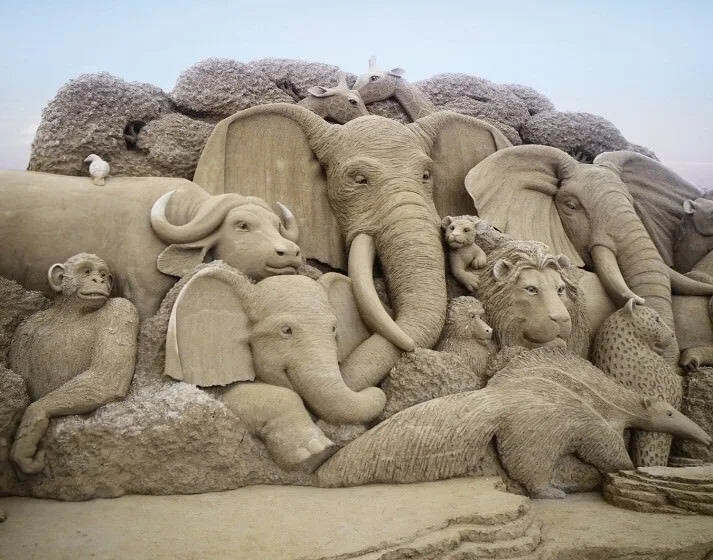Africa, a sculpture Fralich carved for an exhibition in Tottori, Japan.
Nothing is permanent. Partly for this reason, artists create as an attempt to leave behind a tangible mark, something enduring. Karen Fralich, a full-time professional multimedia sculptor, is an exception: her art isn’t meant to last forever. After completion, every one of her striking sand sculptures will eventually bow to the mercy of Mother Nature, washing into the sea or disappearing back into the beach.
Yet the three-time World Champion and three-time North American Champion of sand sculpting doesn’t let it faze her. Fralich sees worlds in grains of sand, and her sculptures—which include a herd of African wildlife, a life-sized Little Red Riding Hood, and an Egyptian tomb made from 25 tons of sand—are incredibly detailed and surreally lifelike. She is a leading competitor in the world of sand sculpting, and she is often the only Canadian representative at international competitions.
Carving sand is as much a feat of engineering as it is an outlet of artistic creativity. “People always want to know what it is that makes [the sculptures] stay like that,” says Fralich. “The secret is the preparation before carving—using a lot of water and layers, like mud.” Sand sculptors start with massive piles of sand formed into bricks or cylinders—their equivalent of blank canvases—that have been encased in plastic or wooden frames. “It’s like a big wet brick or soft sandstone,” she says.
In 1998, Fralich, who began sculpting with clay at the age of 14, started competing internationally. By 2000, she was sculpting full-time. As is the case in sports, going professional takes dedication; you have to work your way up in the ranks. “It’s not quite as cool as the NHL,” Fralich says, “but you can’t just walk into a competition and say ‘Hey, I want to try this.’ ”
Whittling away at a tightly packed cube of sand to form a dragon, cat, or human face requires an intuition that’s not uncommon in engineers; many sculptors have mathematical and technical backgrounds. “Most of the impossible things you see are actually optical illusions, and the sculpture was engineered to look that way,” explains Fralich. “You have to think about structure all the time.” And just as artists travel with a personal set of sketching pencils or brushes, sand sculptors are no different. Fralich arrives at each competition with a complete set of carving tools. Of her favourite—a 16-centimetre trowel that has travelled with her for the past eight years—she says, “It’s like an extension of my hand.”
Occasionally, a completed work might be sprayed with a mixture of diluted glue and water. “It creates almost a candy coating shell, like an M&M candy,” says Fralich, before shrugging it off. “I’ve never used that.” Only sand and water make her ingredient list.
Every competition adheres to strict rules, and participants are given equal amounts of water and sand and designated areas to work with. Natural elements—wind and rain—are usually the reason for each sculpture’s eventual demise (unless the competition grounds need to be cleared earlier). “If it’s just a light rain, you don’t even notice,” says Fralich. “A bit more, you might get a bit of speckling on the sculpture and lose some details, but nothing major. It takes a very heavy rain for a very long time to cause considerable damage.”
Bad weather is bound to strike occasionally. A particularly challenging experience for Fralich occurred when a sudden storm hit the Texas State Fair in October 2002 in the middle of a team build. Eighteen centimetres of rain fell in 12 hours, and their 15-metre Texas-themed sculpture was caught in the downpour. “The rain fell, and we actually watched it melt in front of us,” she says. Starting from scratch, she quickly chiselled out a dinosaur while another team member formed a map of Texas to replace what was demolished.
In 2004, at the world-famous Harrison Hot Springs competition in British Columbia, Fralich was named the First Place Solo World Champion and awarded the Sculptor’s Choice honour for one of her favourite artworks to date, a stylized Haida-themed piece that included depictions of First Nations elders. It took five hours of solo work just to compound the sand and another 20 hours to carve it over three days.
Fralich has many upcoming projects; she travels multiple times each month to compete internationally. Recent voyages have taken her to Texas, Japan, and Russia. This summer, she’ll be directing the Canadian National Exhibition’s International Sand Sculpture Competition in Toronto for the third year in a row.
Photographs of the sculptures don’t do them justice—but, in the end, that’s all that will remain of them. As Fralich says, “It is just sand and water.” Their intrinsic impermanence only makes their brief presence all the more poignant. And, for works of art that look as though they’re about to come to life, it is blissfully ironic that they have such a short-lived existence.

